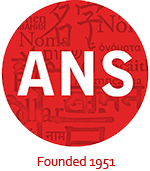 Ever thought about getting more involved with the American Name Society but did not know how? Here is your opportunity! The American Name Society is currently looking for a few good people who are interested in joining the Executive Council, as well as the Editorial Board. Starting January 2021, new officers will be needed to fill the positions listed below.
Ever thought about getting more involved with the American Name Society but did not know how? Here is your opportunity! The American Name Society is currently looking for a few good people who are interested in joining the Executive Council, as well as the Editorial Board. Starting January 2021, new officers will be needed to fill the positions listed below.
To apply for one or more of these Executive Council positions, please fill out the application form on this page.
The person elected to this position will be responsible for maintaining the ANS social media presence via our website as well as Facebook and Twitter. The main duties for this position include the following: updating the news page of the ANS website on a weekly basis; posting special alerts (e.g., conference announcements, calls for papers, ANS newsletters); responding to requests made via the Facebook and Twitter accounts; and adding books that are reviewed in NAMES to the ANS Amazon Wishlist. The person chosen for this position must not only be highly computer literate, but also an avid user of social media. Experience in using WordPress is desirable but not mandatory. Training will be provided. The new Information Officer must also have excellent writing and time-management skills as well as a high level of creativity. The Information Officer will work very closely with the ANS President and Vice President throughout the year.
Allied Conference Coordinator (2021-2023)
The person elected to this position is principally responsible for organizing the ANS session at the annual conference of the Modern Language Association. This activity involves issuing a call for papers, assembling a team of abstract reviewers, selecting three authors whose work will be presented at the MLA conference, and coordinating the presentation of the three winning abstracts with the MLA administration. In addition to these duties, as a voting member of the ANS Executive Council (EC), the Allied Conference Coordinator participates in the legislative decision-making of the Society. Although the term of service for this position is for two years, the holder of this office may be re-elected pending approval by the EC. Given the fact that this position requires close communication with the MLA, candidates who have a demonstrated expertise in literary onomastics will receive preference.
Member-at-large (2021-2023)
The person elected to this position will serve as a voting member of the Executive Council (EC) and is expected to participate actively in the legislative decision-making involved in resolutions and motions placed before the EC. In addition to these duties, members-at-large serve on various auxiliary sub-committees to, for example, help with the nomination of new officers, coordination of the annual conference, and organization of allied conferences. Officers in this position can renew their term of service twice.
Names Editorial Board
We are currently seeking new applicants to join the NAMES Editorial Board. Although onomastic specialists in all areas of onomastic research are welcome to apply, we have a particular need for scholars with expertise in the following areas: toponymy, literary onomastics, anthroponymy, corpus/computer linguistics. Interested applicants should be native or near native speakers of English, have published in onomastics, and be a member in good-standing of the ANS or an allied onomastic scholarly society (e.g. The Canadian Society for the Study of Names, the International Council of Onomastic Sciences, The Society fro Name Studies in Britain and Ireland, etc.). Familiarity with a modern language other than English is also a bonus. As a general rule, editorial board members will not be expected to review more than 2 manuscripts per month. In addition, once a year, all members of the Editorial Board participate in the selection of the Best Article of the Year. If you are interested in joining our team, please complete and return the application from found at the following link: https://nick662.typeform.com/to/P6dzaz. If you have any questions, please do not hesitate to contact Professor I. M. Nick (nameseditor@gmail.com).



 Cleveland takes its name from General Moses Cleaveland, a surveyor and investor for the Connecticut Land Company who led the first group to settle in the area in 1796. Cleaveland oversaw the planning of the early town, then headed back to Connecticut a few months later and never returned to the town that bears his name.
Cleveland takes its name from General Moses Cleaveland, a surveyor and investor for the Connecticut Land Company who led the first group to settle in the area in 1796. Cleaveland oversaw the planning of the early town, then headed back to Connecticut a few months later and never returned to the town that bears his name.

 Read
Read  One of the country’s most famous landmarks probably will keep its
One of the country’s most famous landmarks probably will keep its  The
The  Ever thought about getting more involved with the American Name Society but did not know how? Here is your opportunity! The American Name Society is currently looking for a few good people who are interested in joining the Executive Council, as well as the Editorial Board. Starting January 2021, new officers will be needed to fill the positions listed below.
Ever thought about getting more involved with the American Name Society but did not know how? Here is your opportunity! The American Name Society is currently looking for a few good people who are interested in joining the Executive Council, as well as the Editorial Board. Starting January 2021, new officers will be needed to fill the positions listed below.